CEO's address
The year 2022 started with a large number of infections of the omicron variant, and the activities were colored by that until spring.
From the fall of 2022, a large part of the medical staff has been Danish, in addition to the fact that we have had nurses from various countries in the staff. This is a welcome addition to the workforce, which otherwise would not have been able to handle the projects. Although language difficulties can be a problem in some cases, the cooperation has gone very well.
Reform projects continued in various areas. As the summary of the performance indicators attached to this annual report shows, many things have gone as planned, but others less so, as things go. This year is the last year that work is carried out according to strategy 2020–23 and therefore it will be necessary to make a new strategy at the end of the year, where lessons will be learned from this and a new strategy will be marked in the context of the changed situation and the government's changed priorities.
The organization's finances, along with the normal demands made on the activities, have been a challenge. Before the budget increase law and other transfers came into being, the business was headed for a deficit of well over three hundred million. In particular, we believe that the nursing facilities are underfunded. Nursing homes under contract with the Íszúkratyringar Íslands received a significant correction last year, but it has not yet been fully calculated how such a correction would play out for state-run nursing homes.
Still holds the rating of the institution in a survey about Organization of the year continues to rise and for the second year in a row the institute is in the top position among its sister institutes. With satisfied staff, the Westfjords Health Institute can continue to fulfill its role as a key institution in Westfjords society.
Gylfi Ólafsson CEO
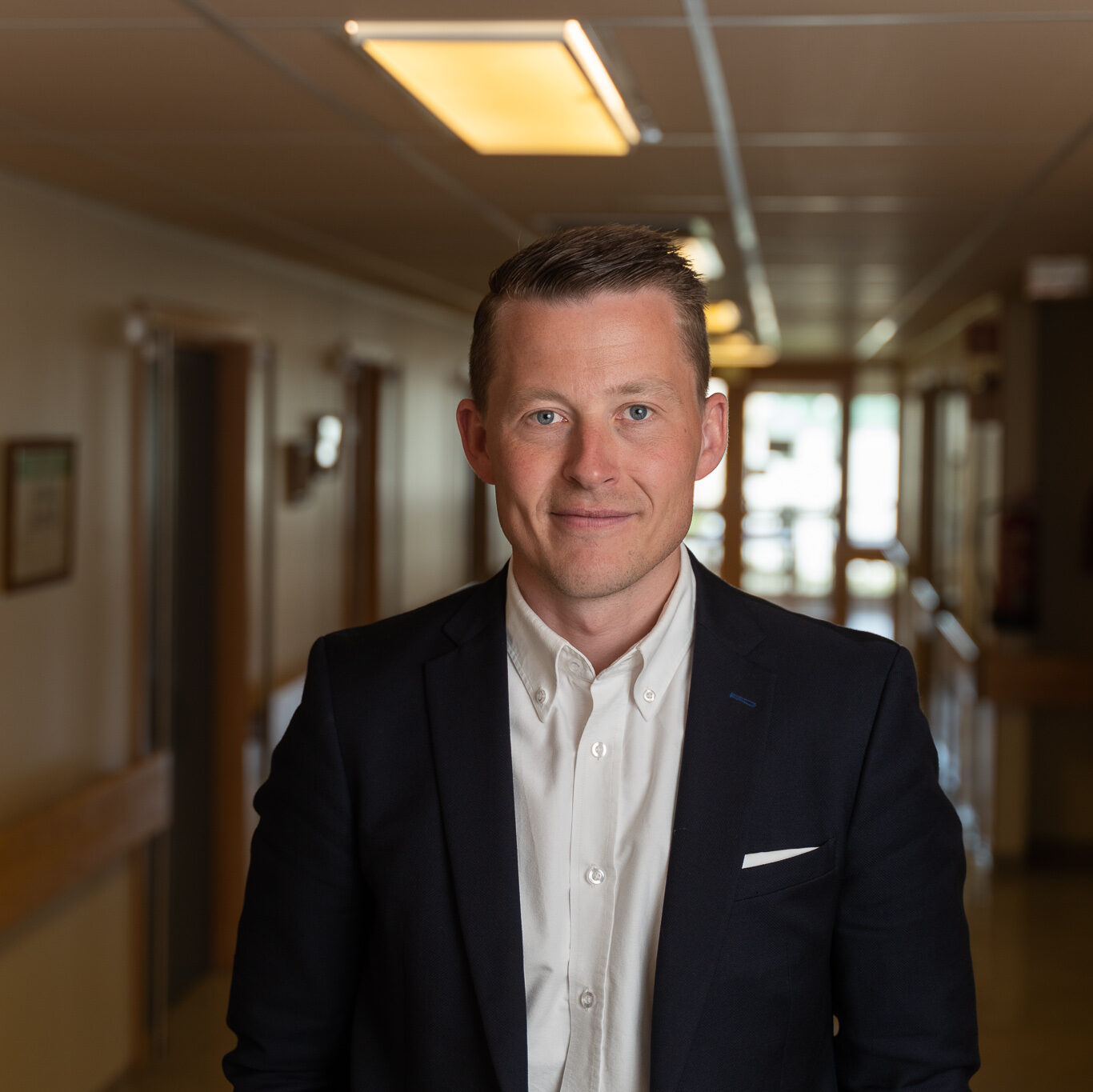
Settlement of performance indicators
In the organization's policy set for the year 2020–23, performance indicators were presented in two sections, main performance indicators and other more detailed ones.
Performance indicators of this type are problematic tools. They need to measure something that really matters (preferably directly related to the organization's overall goals), that it's easy to collect, that it doesn't create the wrong incentives, and that it measures what it's intended to measure. Then there is little point in measuring things that are not in the power of the organization to change. Goals must be set in such a way that they are both ambitious and achievable.
Then the world changes from the time a performance indicator is presented until it is settled. Some data is no longer available, emphasis on others changes.
In health care, many shortcomings depend on the fact that it is difficult to measure actual services. Performance indicators of this type tend to be external measures; measures of equipment and administration of various kinds, but not the core activities themselves.
Now the performance indicators are made up for the second time. The result is that four were achieved, two were not achieved and three were achieved to a considerable extent or it is a matter of definition whether they were achieved.
Electrification of processes has progressed considerably, and invoices, for example, are no longer sent by post except in exceptional cases. However, the results have not been as fast as the goals assumed.
RAI quality indicators are almost within limits. The organization's effectiveness in distributing information has been good, both on the website and on Facebook, which has proven to be the most convenient platform. Green steps were not achieved through formal means, but many steps were taken in that direction in various areas.
Job satisfaction is according to goals, but the implementation of annual staff meetings has not gone as planned. In-house information provision through the active use of Workplace has been successful.
According to the annual report, there was a slight surplus from operations, but that is due to an extremely large additional budget at the end of the year, so there is a yellow color.
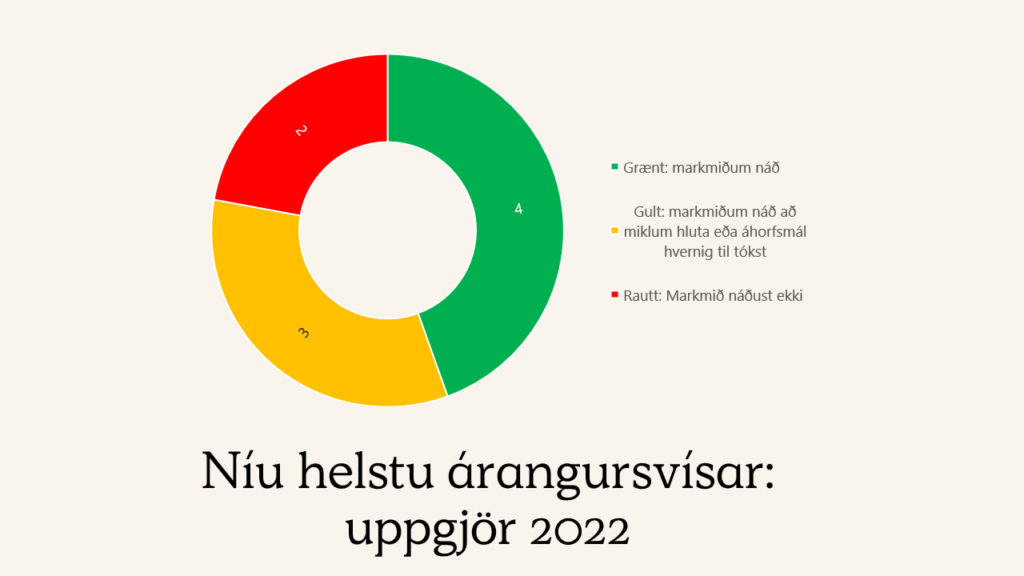
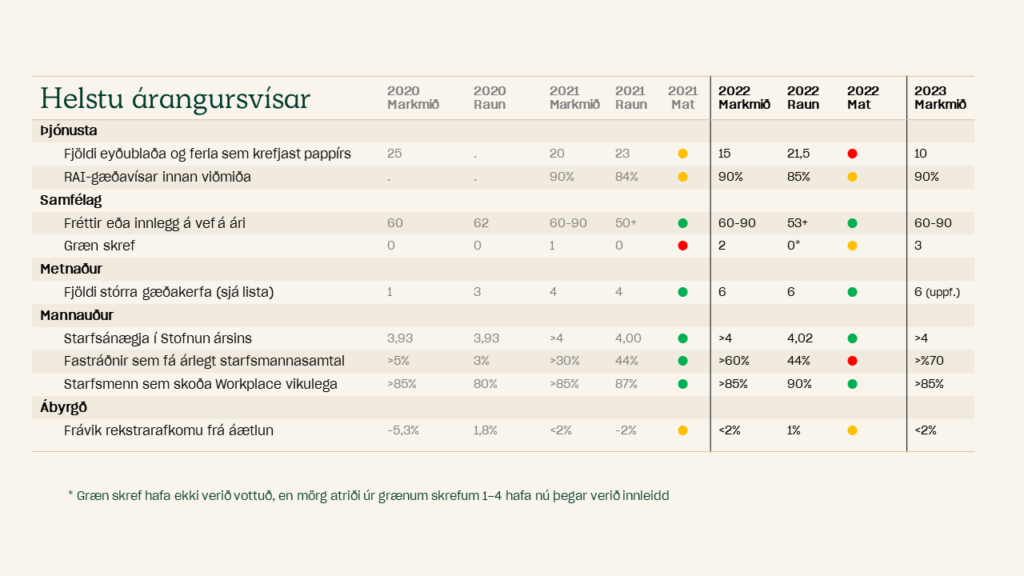
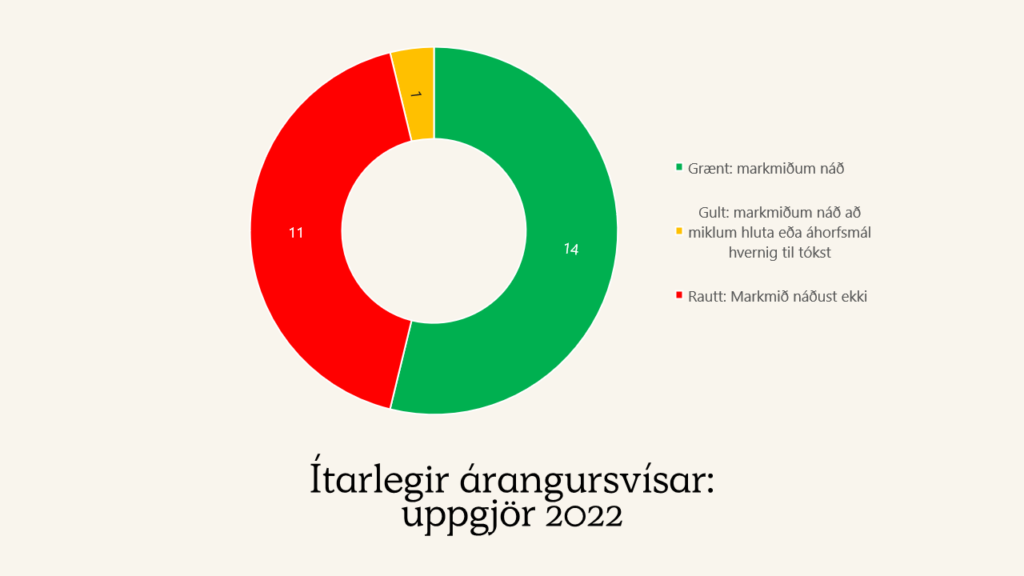
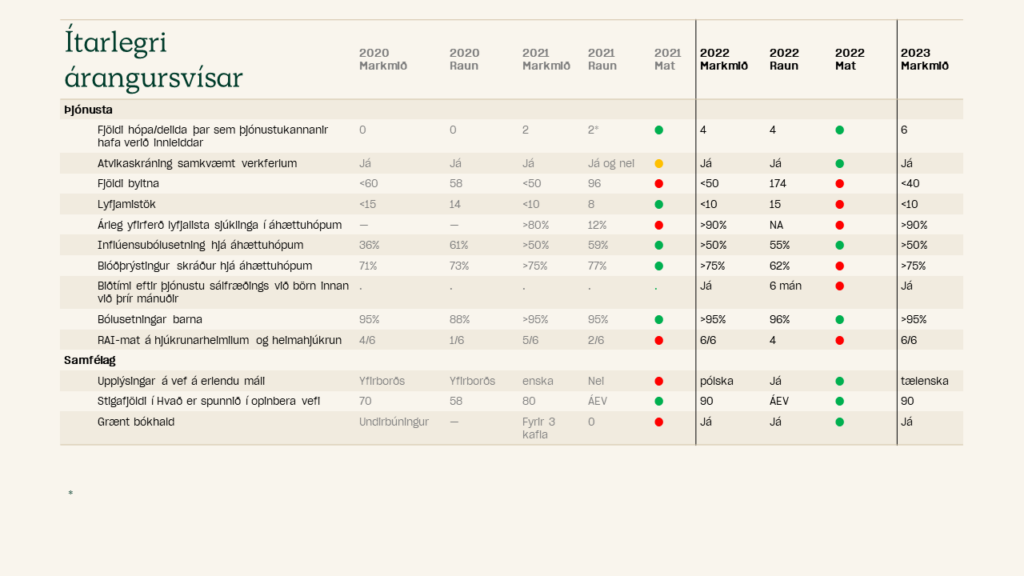
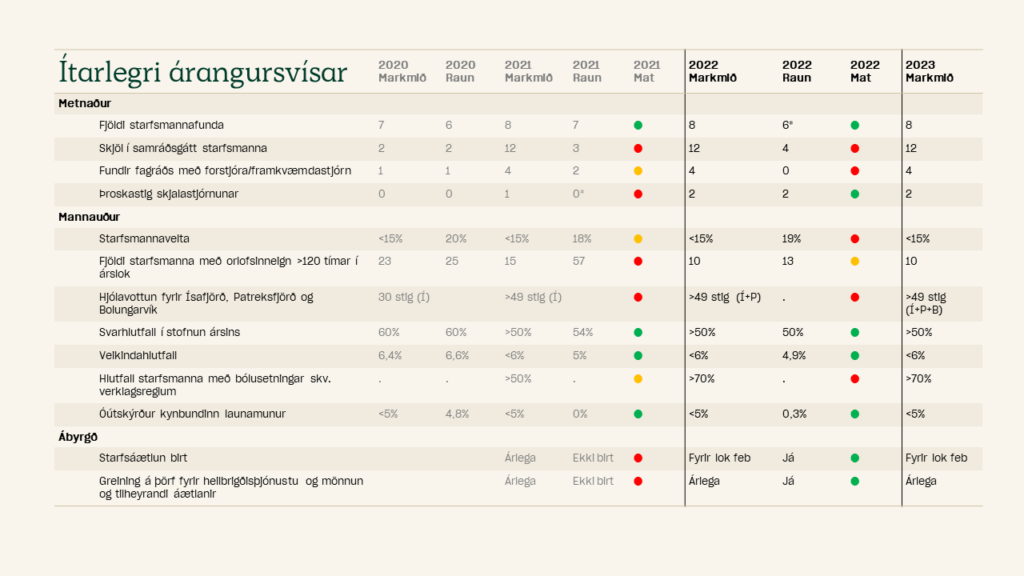
The more detailed performance indicators, which were originally meant to be for indoor use only, became 14 green, eleven red and one yellow.
In the green party we set up service surveys, where we are entirely dependent on the surveys carried out on a national level by the Icelandic Health Insurance and the Ministry of Finance and Economy.
Incident registration has been successful, influenza vaccination for high-risk groups, children's vaccinations, information on the website about foreign affairs, improved accessibility on the website and green accounting, which was done for the first time in 2022. Then we will have staff meetings on the green side, because although there are not quite as many and objectives indicated that the disclosure has been consistent internally.
A major project on improved record keeping, with the implementation of the electronic file system MAFS, resulted in two maturity levels as defined by the National Archives. Response rate in Organization of the year was excellent, the sickness rate was within limits, no unexplained salary differences, and improvements were made in planning.
Yellow color is placed on the number of employees with excessive leave credits, with a significant effort reducing the figure from 57 to 13.
Red color is placed on the number of breakthroughs, medication errors and the annual review of the medication list. You have to look specifically at what is good to take here.
Blood pressure registration decreased after being very good in 2021, but the health care financing system has also changed and not as much emphasis was placed on this. The waiting time for the services of a psychologist was still too long, but there has been a great improvement in service in recent terms in all mental health services with two psychiatric teams, case managers, mobile and remote psychologists and various other things. RAI assessment has not been adopted in home care or nursing homes in Patreksfjörður, but has been adopted elsewhere.
The employee consultation portal has not taken off, although consultation takes place mainly at staff and management meetings, as well as through informal channels. Meetings of the professional council have been canceled due to absences and personnel changes. Employee turnover was slightly higher than expected. A bicycle certification project was put on hold. Vaccinations of employees according to procedures were launched in full force at the beginning of 2023, but receive a red dot for 2022.
Organization of the year
The overall score in Sameyki's survey about the organization of the year rose even more, and was 4.02 in the last measurement. The institution was the highest among its sister institutions for the second year in a row, now equal to the Eastern Health Institute. This is a very gratifying result.
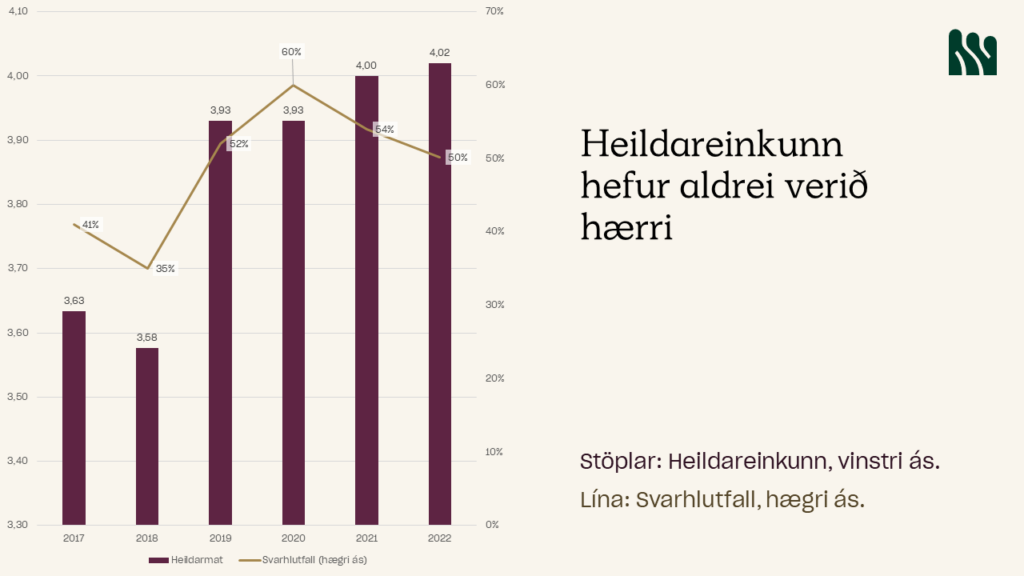
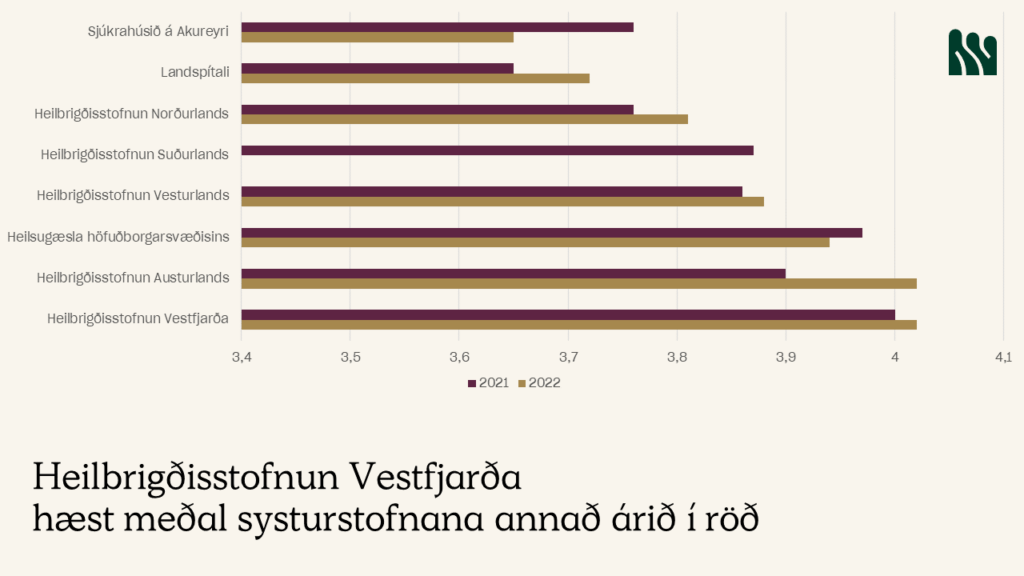
Annual accounts 2022
As before, the organization's operation is a great challenge, but ways are constantly being sought to achieve efficiency in operations through increased restraint, increased cost awareness and technological innovations. The result for the year 2022 was headed for a deficit of 332 million ISK, which is partly an accumulated deficit, but with additional funding, the situation was reversed and the result for the year ended positive by 20.8 million ISK. Fees increased between years by 286.7 million ISK or 8.6%. At the same time, income increased considerably more or by 369.0 million ISK or 11.3%.
The weight of labor costs was 72% and increased by ISK 173.6 million or 7.2%. The average number of full-time positions increased by 13.4 full-time positions between years, or by 7.0%. The weight of other operating expenses was 27.1% and increased by ISK 109 million or 12.5%. The increase can be attributed primarily to an increase in specific product purchases, driving including ambulances and specialist services. Depreciation increased by 4.1 million ISK or 15.8%, but the year's investments amounted to 36 million ISK. The weight of budgets was 92.9% and increased from the previous year by ISK 359.6 million or 12.0%. The weight of sold services was 5.7% and increased by ISK 11.4 million or 5.8% between years. The increase can be attributed to specialist services, accommodation fees and various service income. –ES
| Income | 2022 | 2021 | |
| Revenue transfer of budgets | 3,367.1 m | 3,007.5 m | |
| Sold service. | 207.2 m | 195.8 m | |
| Contributions and miscellaneous income. | 20 m | 26.1 m | |
| Income recognition of deferred income of previous years | 30.3 m | 26.1 m | |
| Total income | 3,624.6 m | 3,255.5 m | |
| Fees | |||
| Wages and staff costs | 2,596 m | 2,422.3 m | |
| Other operating expenses | 977.5 m | 868.5 m | |
| Depreciation | 30.3 m | 26.2 m | |
| Total charges | 3,603.8 m | 3,317.0 m | |
| Performance for capital items | 20.8 m | -61.5 m | |
| The result of the year | 20.8 m | -61.5 m |

Quality indicators for nursing homes
For some time now, the government has set quality standards for the operation of nursing homes.
Poor quality standard (upper limit) is the criterion that is believed to describe a problem that exists regarding the care and treatment of the resident. This subject needs further investigation and needs improvement
Good quality standard (lower limit) is the standard considered to describe good or excellent care and treatment. There is a need to work to maintain that quality and if possible improve it even further.
The Vestfjörður Institute of Health has set the goal that 90% of these indicators are on the right side of the red line. By 2022, it reached 85% cases.
Breakdowns - Breakdowns have decreased over the years, but are still above the quality standards we want. In recent years, we have made an effort to register breakthroughs in incident registration history. We are always looking at rollover prevention improvements.
The prevalence of urinary catheters is in the red, but there are many reasons for their use. In the nursing homes, the emphasis is on using a urinary catheter when all other remedies have been tried. Despite the prevalence of urinary catheters, the prevalence of urinary tract infections is within limits.
Nine or more medications - it is emphasized that clients' medication lists are reviewed regularly by a doctor, and we think that is more important than the number of medications. It has proven to be difficult to reduce the number of types of medicine, as everything is included in this list, fish oil, vitamins, eye drops, laxatives and more.
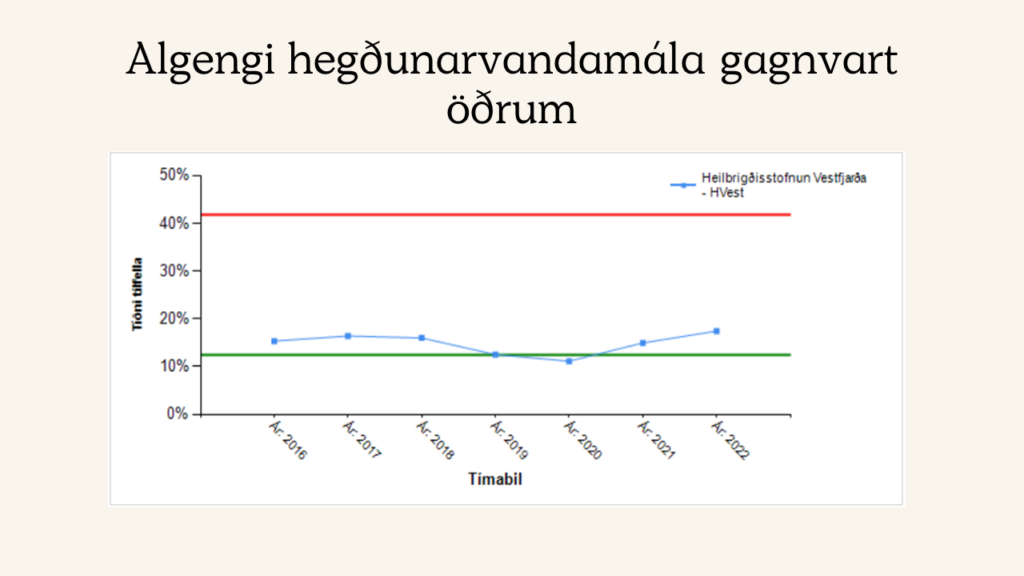

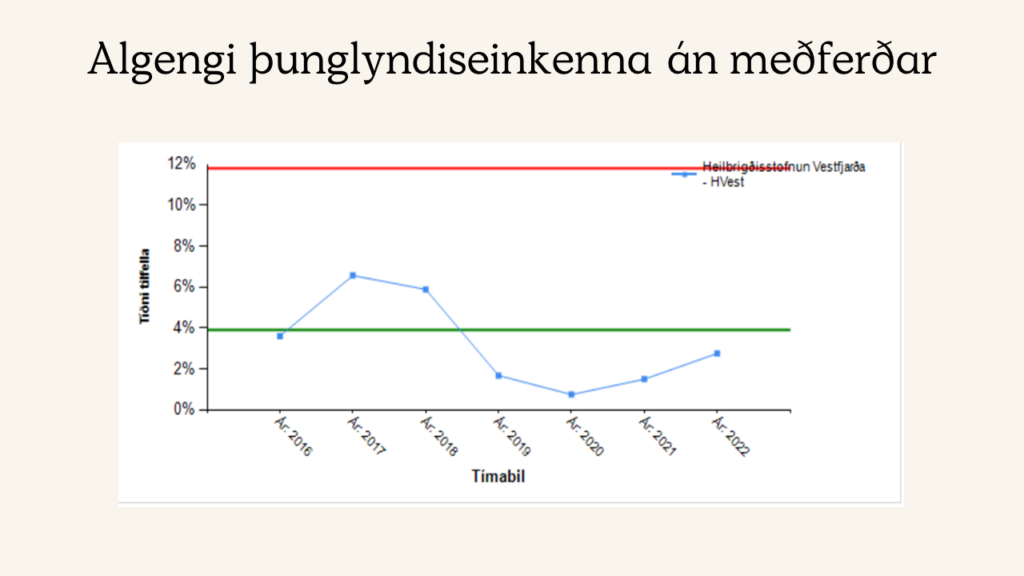
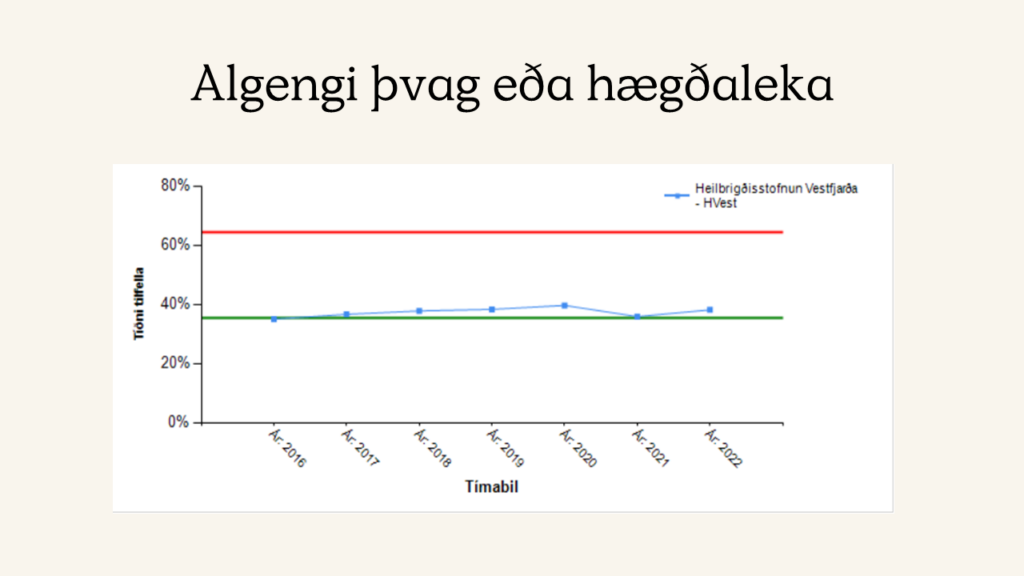

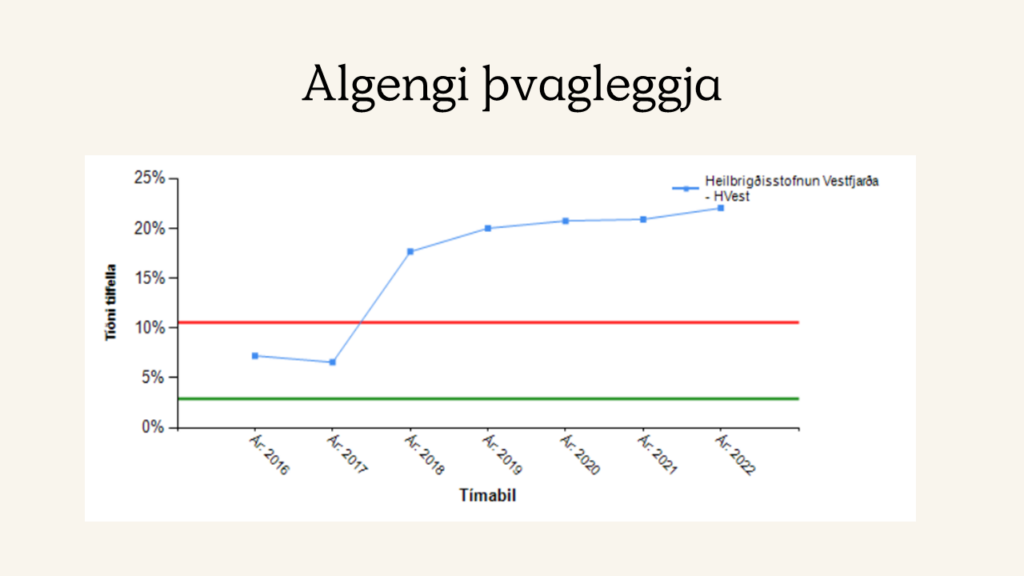
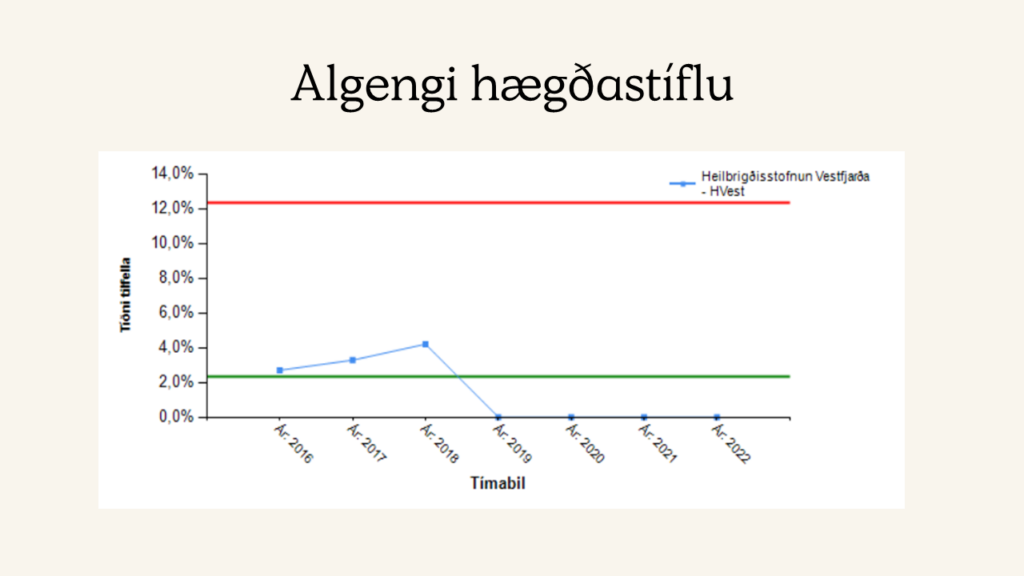
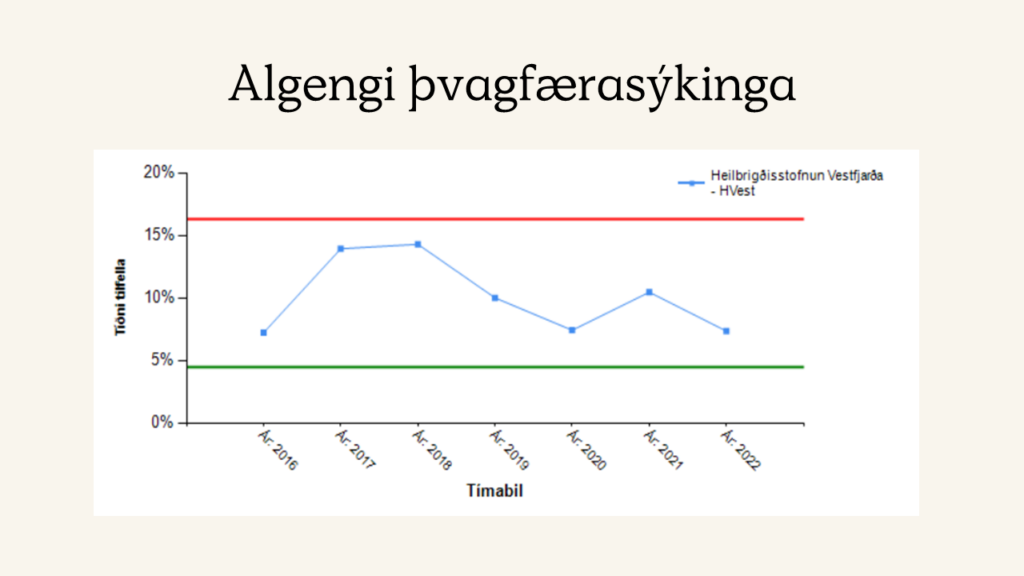
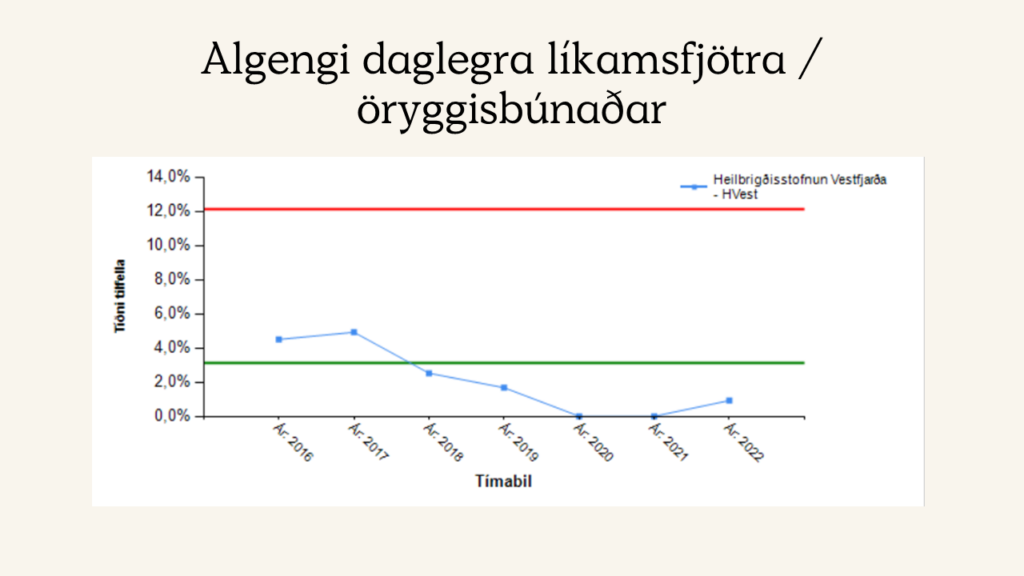
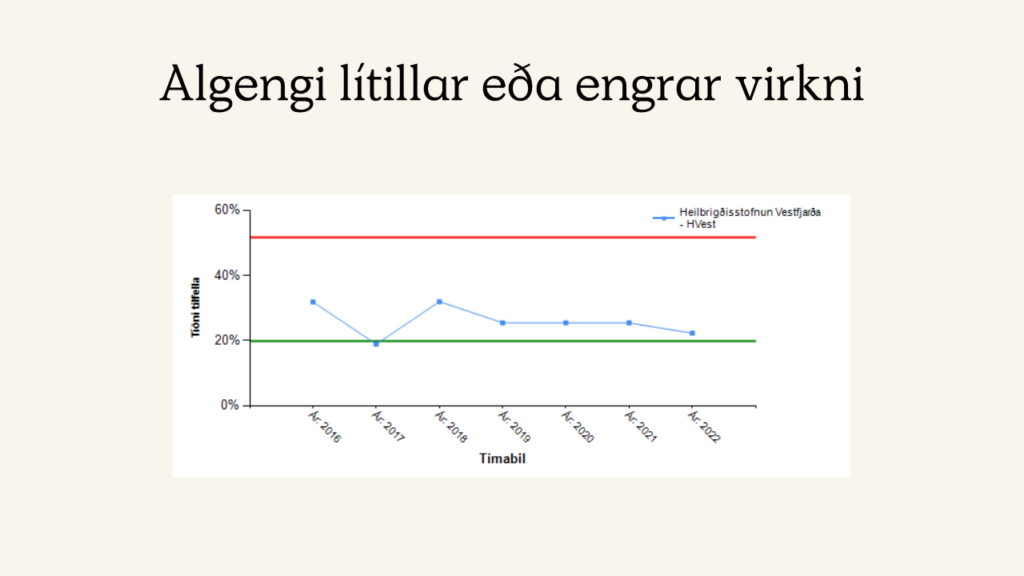
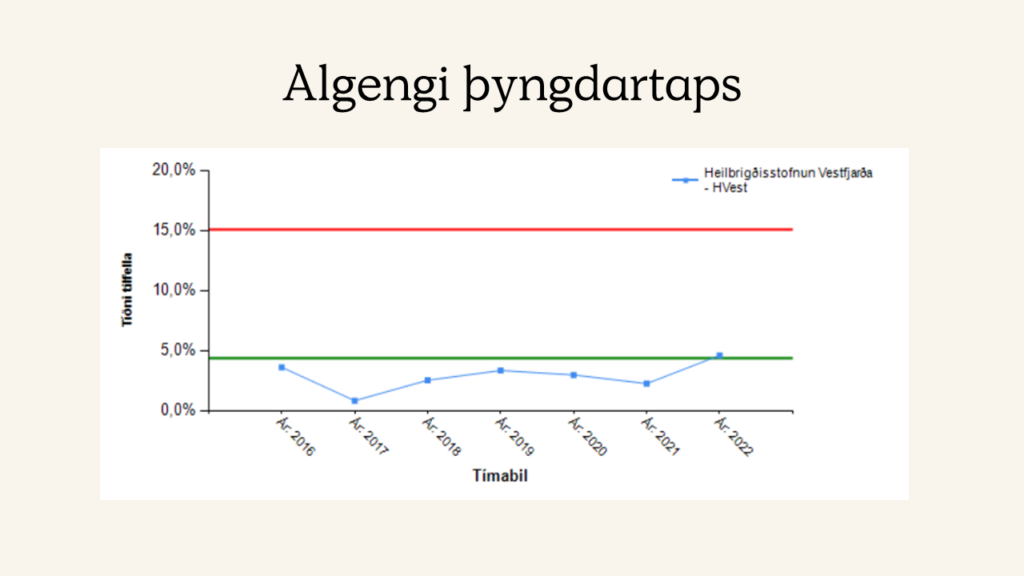

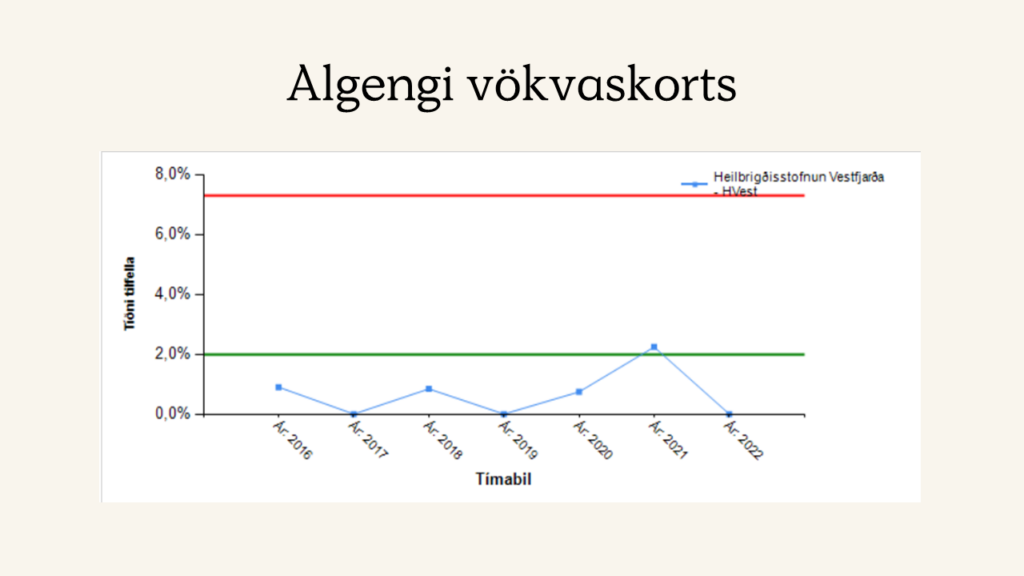
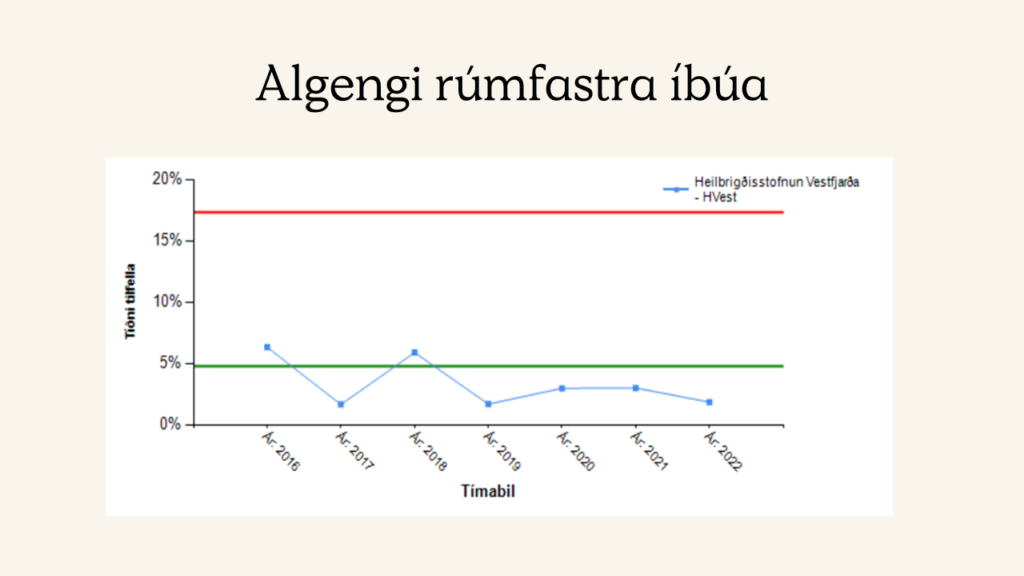
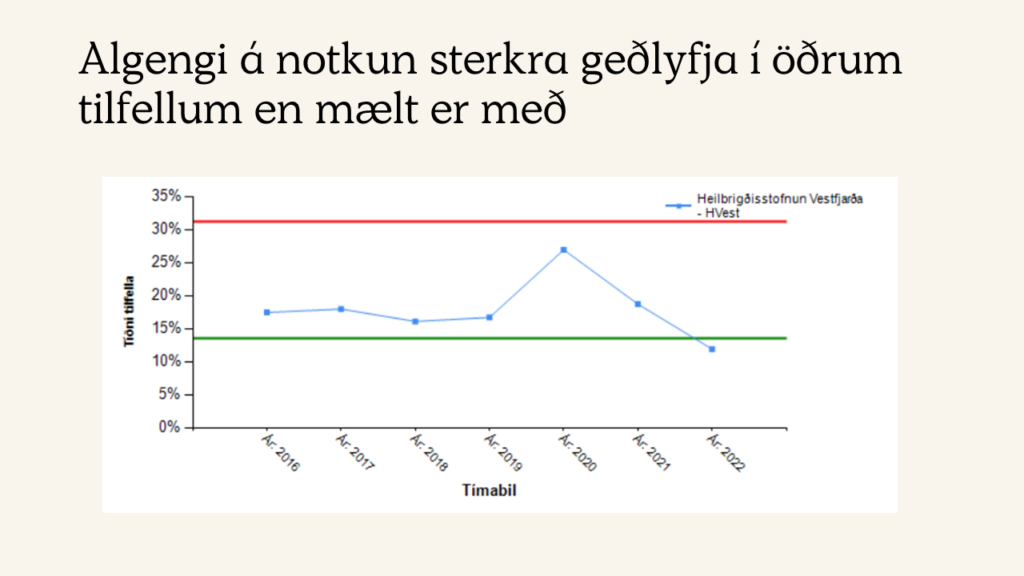
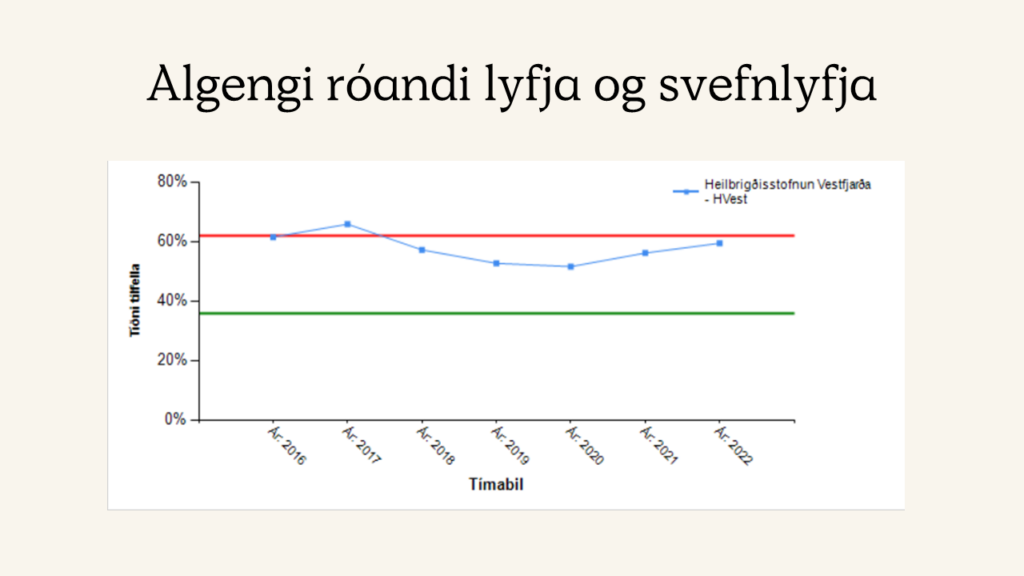


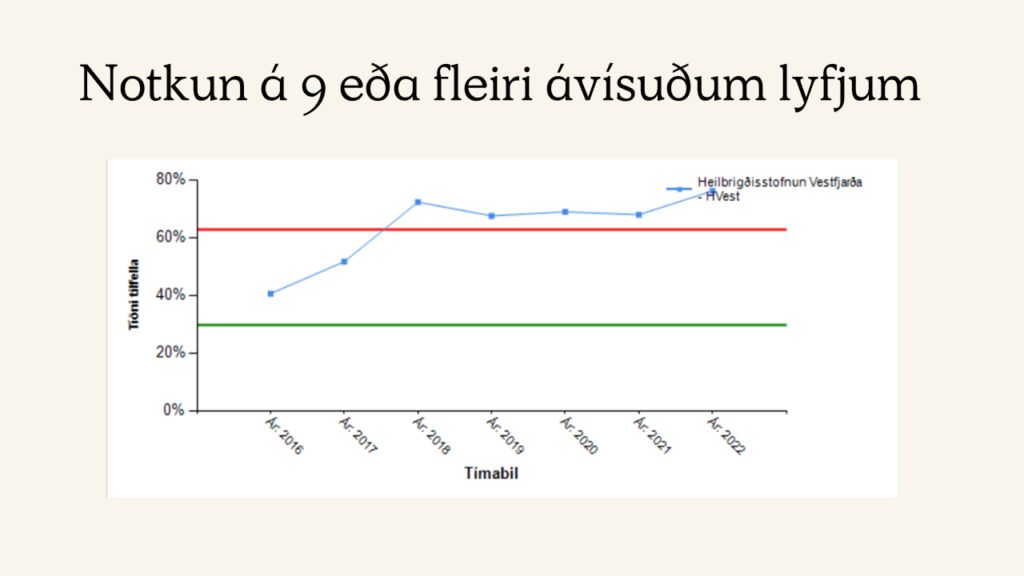

A short story from home nursing
During the year, the program Smásaga was introduced. The program enables home care staff to plan a complex day in color and to record even odd conditions and actions. The system is directly connected to Sago's medical record system. This eliminates the duplication of writing notes on the spot and then entering them into the medical record system at the end of the day.
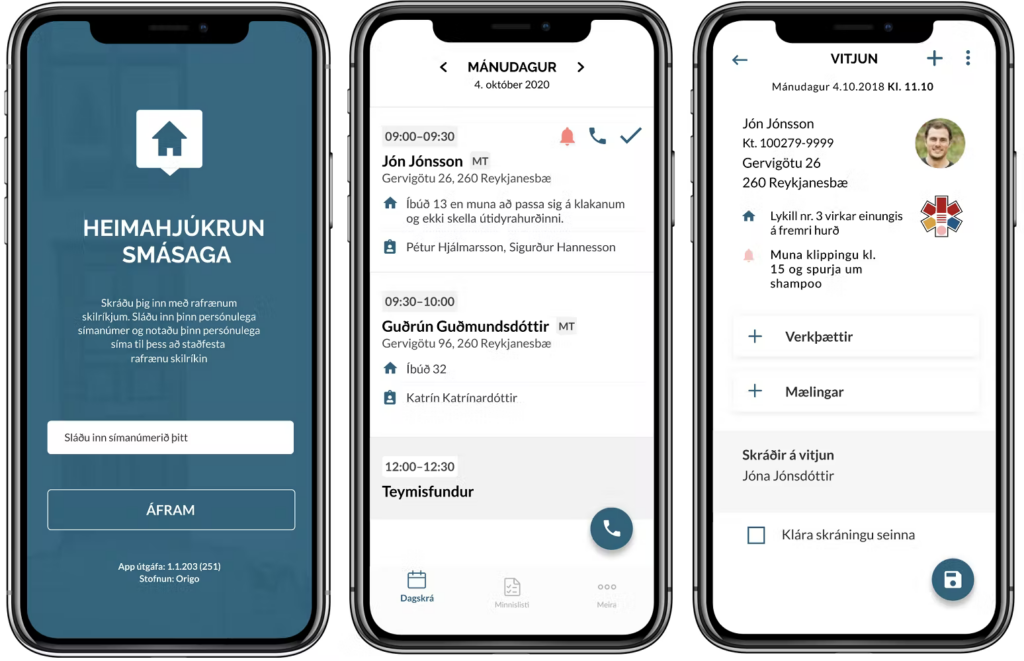
Chronicle
Compared to the last two years, the Vestfjörður Health Institute was not much in the news, but throughout the year there were mainly various announcements and messages from the institute to people about attending sampling and vaccinations. Covid vaccinations and flu vaccinations were the most prominent there, but covid was regularly vaccinated and then flu vaccinations were added as the autumn progressed.
Other news was that at the beginning of June, the presidential couple Guðni and Elísa paid an official visit to Ísafjörður and spent a lot of time visiting the institute.
The organization received several good gifts during the year, and it is the first to count that Ständum saman Vestfjörður delivered a hearing monitoring device at the end of February. The physical therapy at Patreksfjörður received an extremely generous gift from the Patreksfjörður Lions Club, which was a device from NuStep that trains both strength and endurance. The Animal Fjord Department of the Red Cross donated resuscitation equipment to the health care seal in Þingeyri at the end of April. The maternity department received a beautiful gift from Rósbjörga Edda Sigurðardóttir Hansen, who brought the department angel clothes that she sewed and which are intended for parents who lose a child during pregnancy.
The Women's Association of Iceland turned 90 years old in 2020, and on the occasion of this turning point, brought a new fetal heart rate monitor to the maternity unit, which is really useful. Katrín Björk Guðjónsdóttir gave the institute five colorful and beautiful pictures as a gift, which really liven up the sitting room on the second floor.
In March, the institute looked for doctors in Denmark, and many Danish doctors were interested and applied. The first Danish doctors arrived in the autumn and have included general practitioners, a surgeon, a gynecologist and a nurse anesthetist. They have successfully adapted to Ísfir society and most people who have contacted them have been satisfied with their services.
In November, a musculoskeletal reception started at the health care center in Ísafjörður, which has been very successful and helps to relieve the pressure on the doctors. At the end of November, a successful Teddy Bear Day was held and many teddy bear owners showed up with teddy bears that received care.
At the beginning of December, there was a serious accident on Hnífsdalsvegur and an operational command was activated. About thirty employees of the organization were called out due to the accident. It can be said that the operation management exercise that was held at the end of the summer proved its value and helped that the operations went smoothly and everything went as planned.
At the end of the year, it was in the news that the organization's new logo, designed by graphic designer Siggi Odds, was created. silver medal ADCE, the association of artistic directors in Europe, which was very gratifying. Previously, the label had received the FÍT gold medal.
Goodbye good workers
In May, we thanked four employees for their good work for the benefit of the organization and its clients. They have all worked for us for a very long time, at most 32 years. We have been extremely fortunate to have benefited from their efforts all these years.
In the picture are, from left, CEO Gylfi Ólafsson, Sigurbjörg Kjartansdóttir, medical staff, Pálína Jensdóttir, secretary at the rehabilitation department, Heiðrún Björnsdóttir, medical staff, and Hansína Sigurðardóttir, medical secretary.
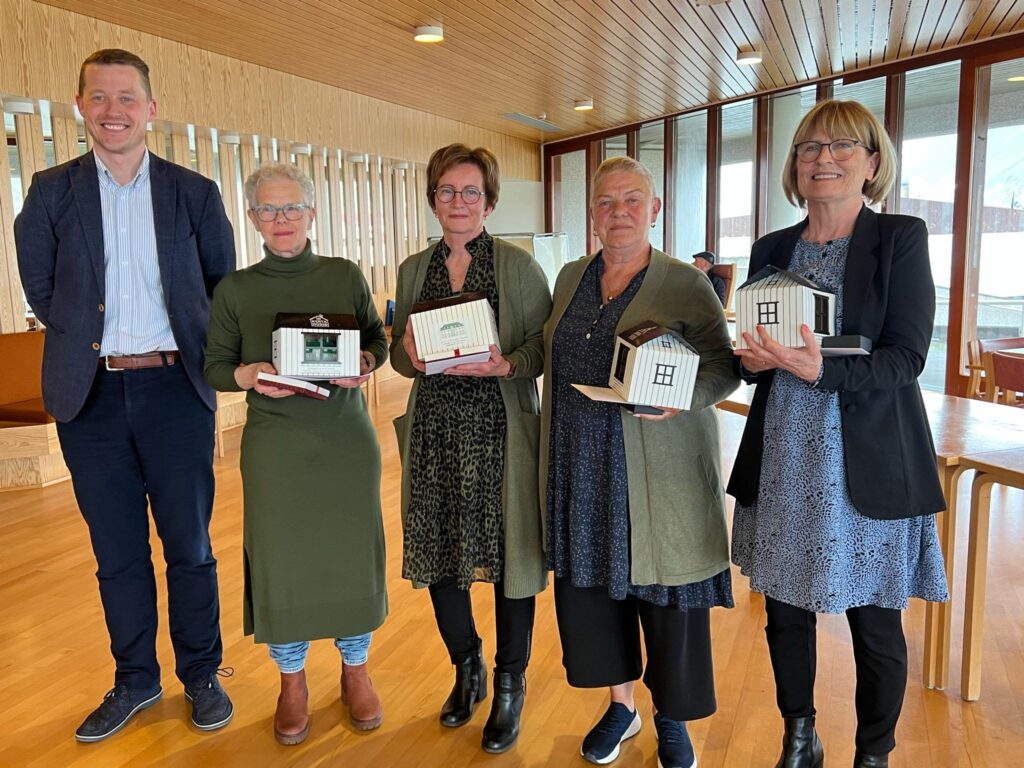
Waiting time for a place in nursing homes has become more pleasant
The Cabinet has published a dashboard of waiting times for a place in a nursing home. It shows that after a high jump, especially in 2021, the waiting time has become more pleasant in the district. During a period, two people had to share a room at Eyri and Berg, but that was soon stopped.
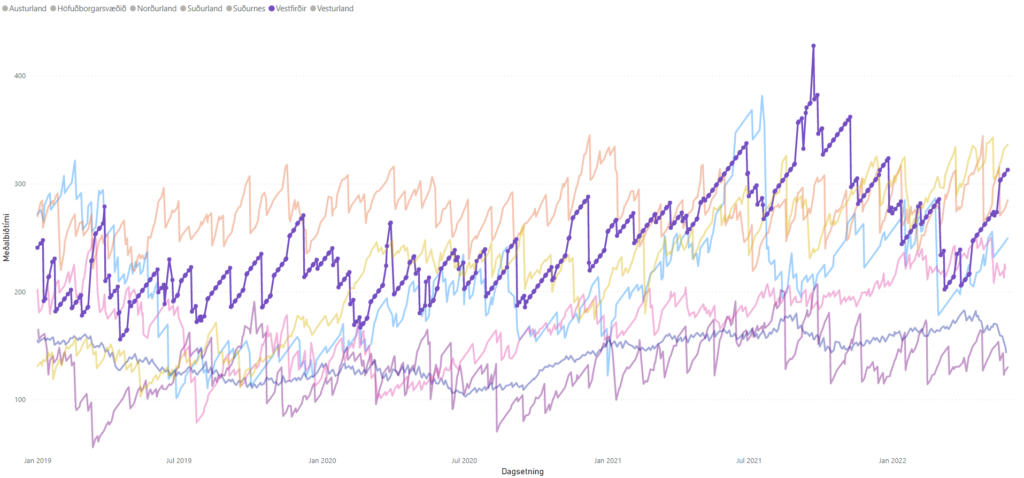
The number of ambulances increased
Ambulances, which had decreased slightly during the epidemic, took off. The increase is greatest in Ísafjörður and in air ambulances.
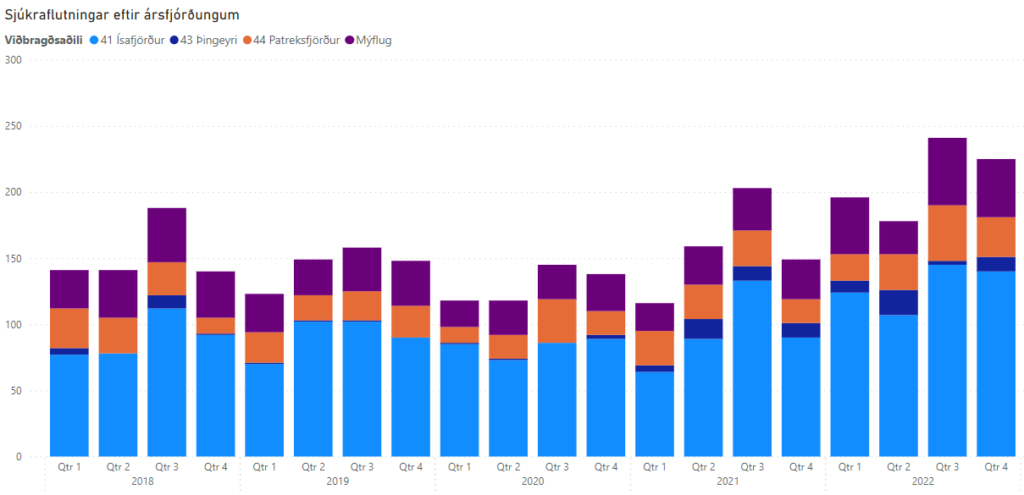
From the director's photo album
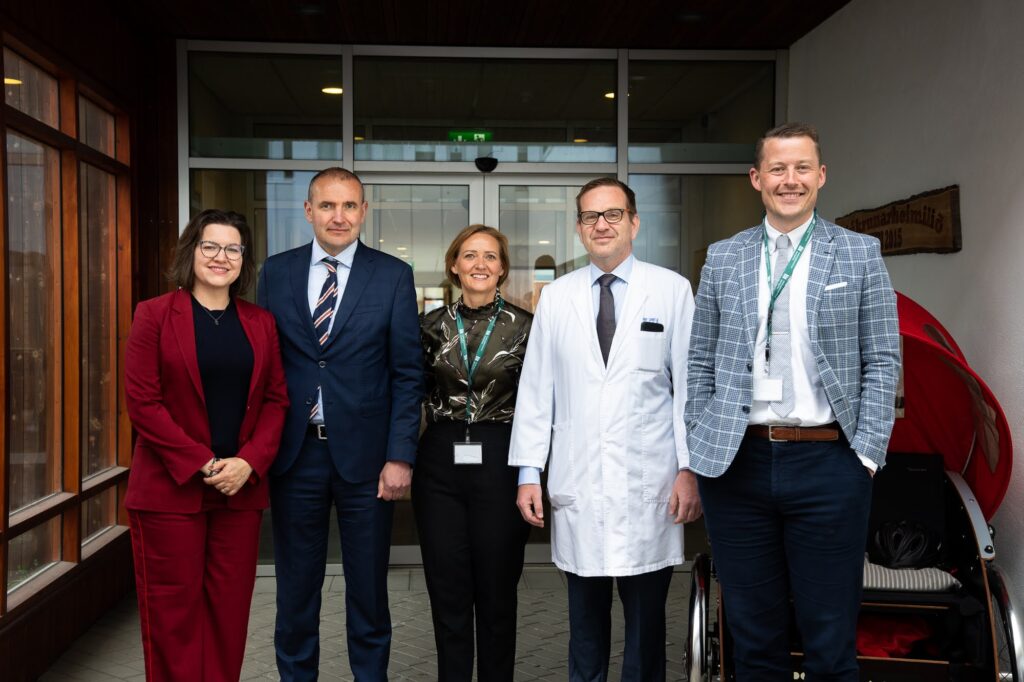
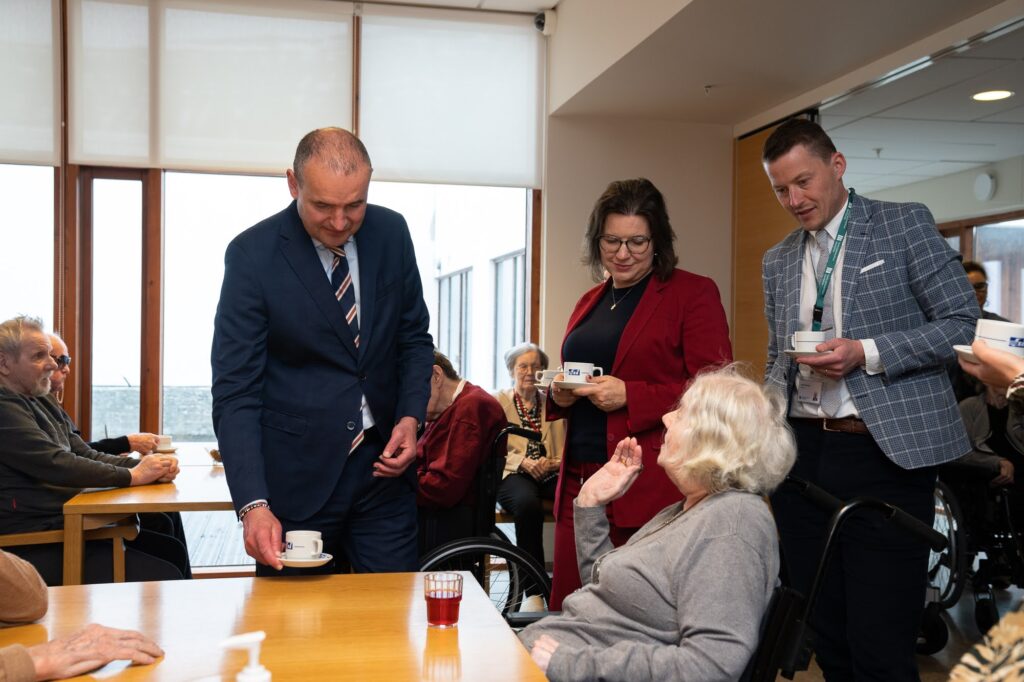
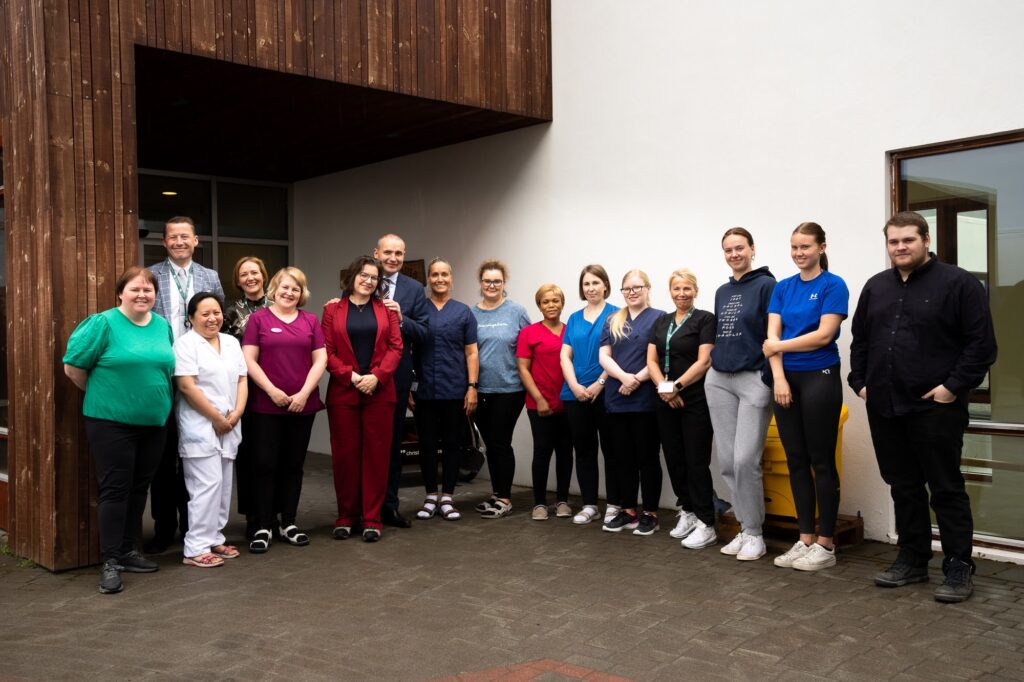

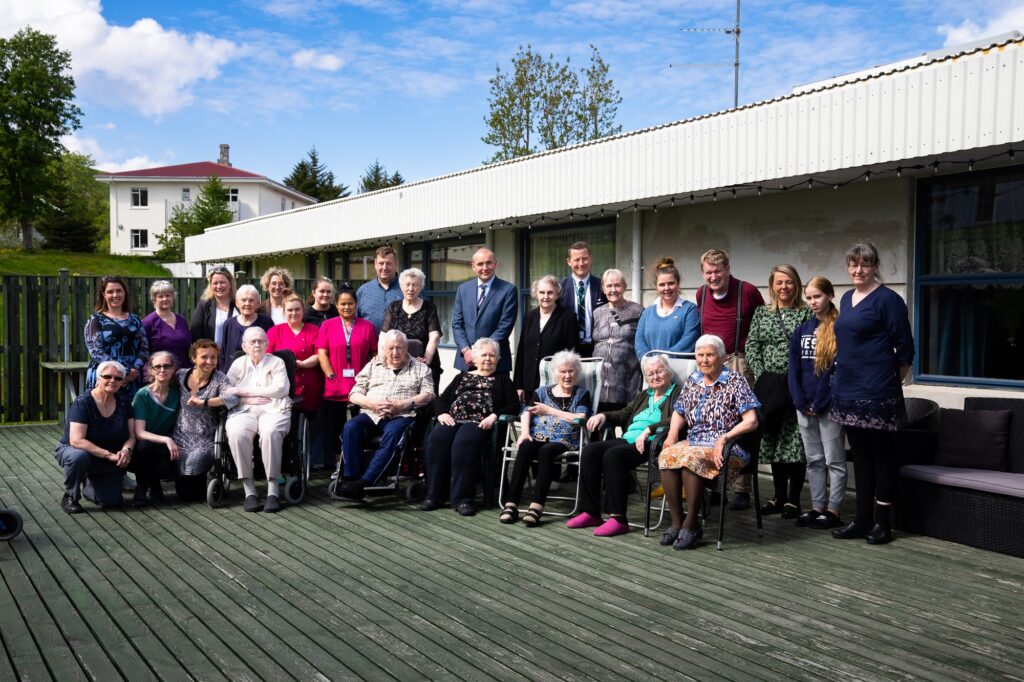

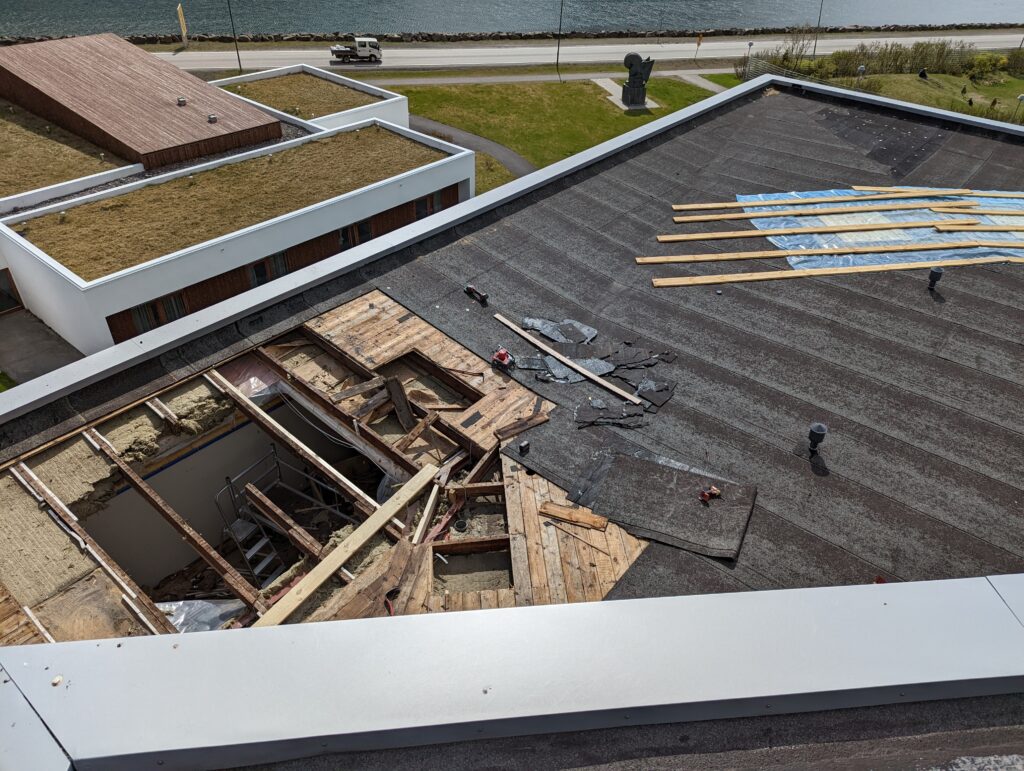
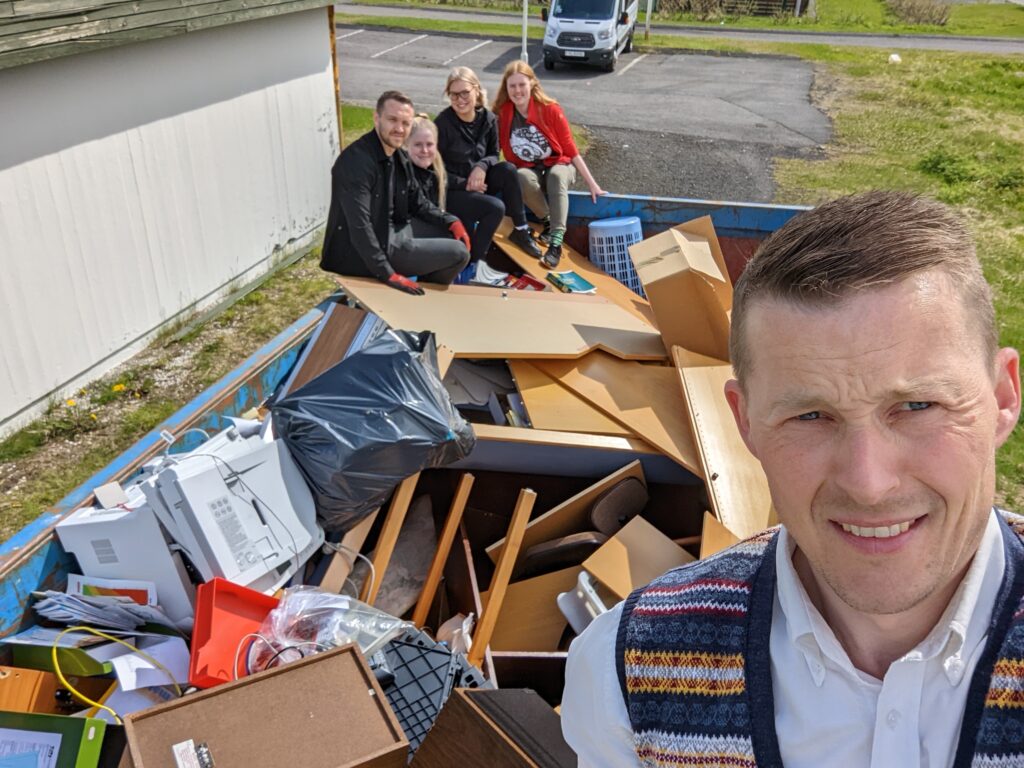
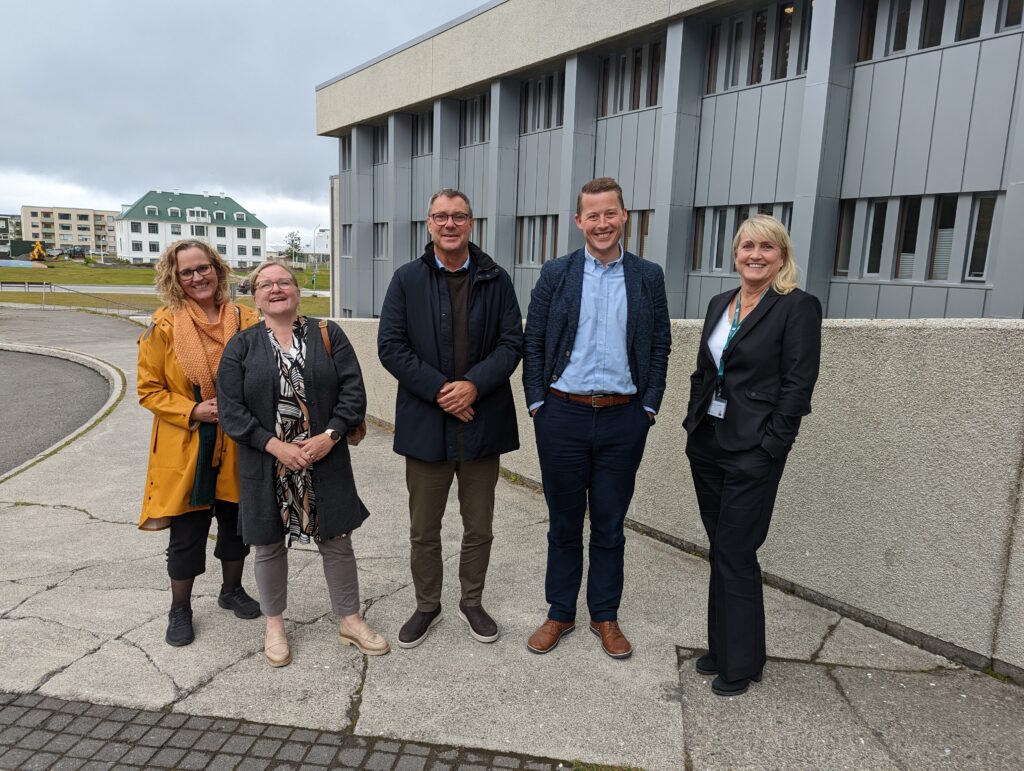
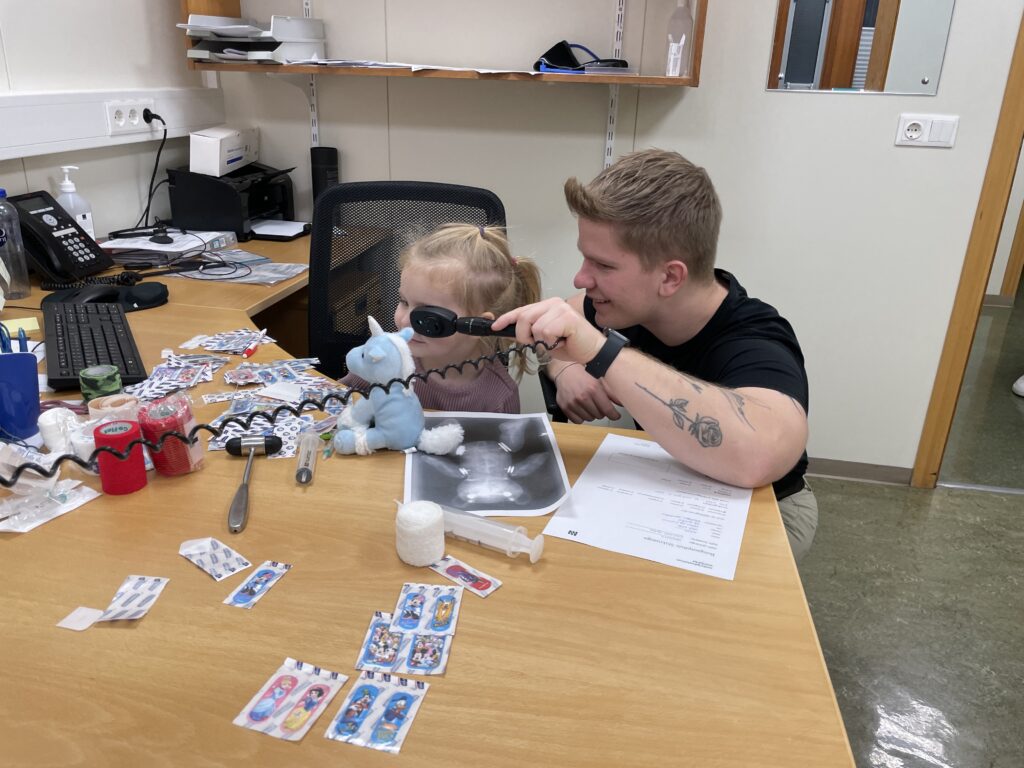
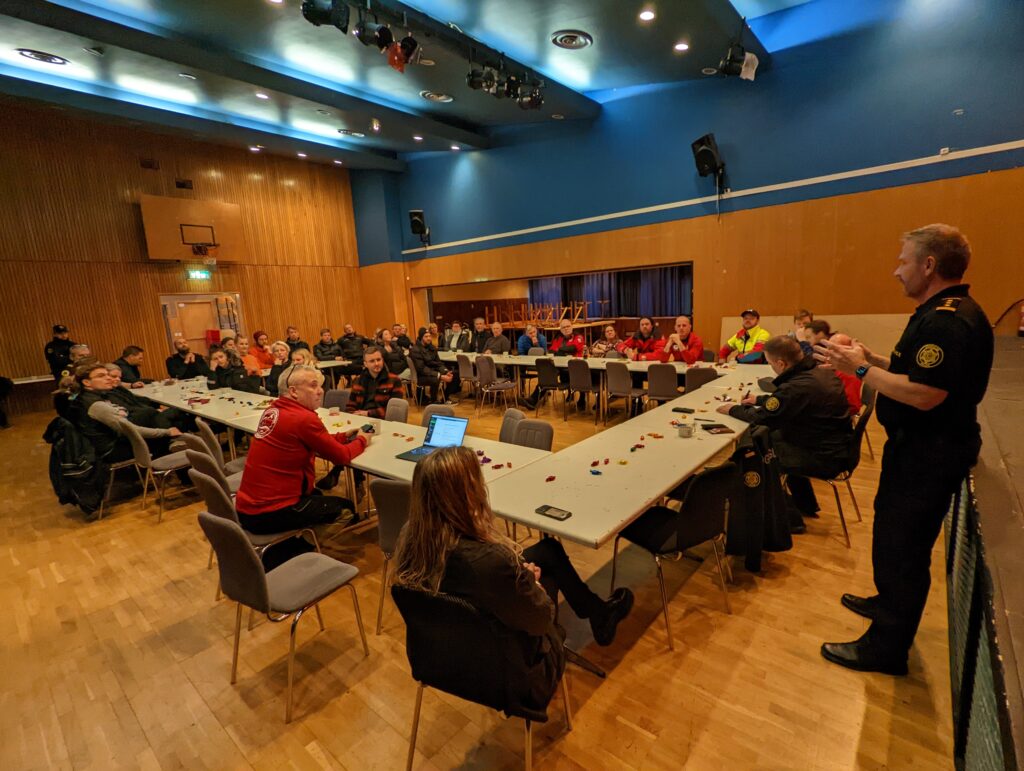
Executive Board
The executive board made two changes during the year. Andri Konráðsson and Hrannar Örn Hrannarsson broke up last summer. Súsanna Björg Ástvaldsdóttir and Elísabet Samúelsdóttir took over from them.

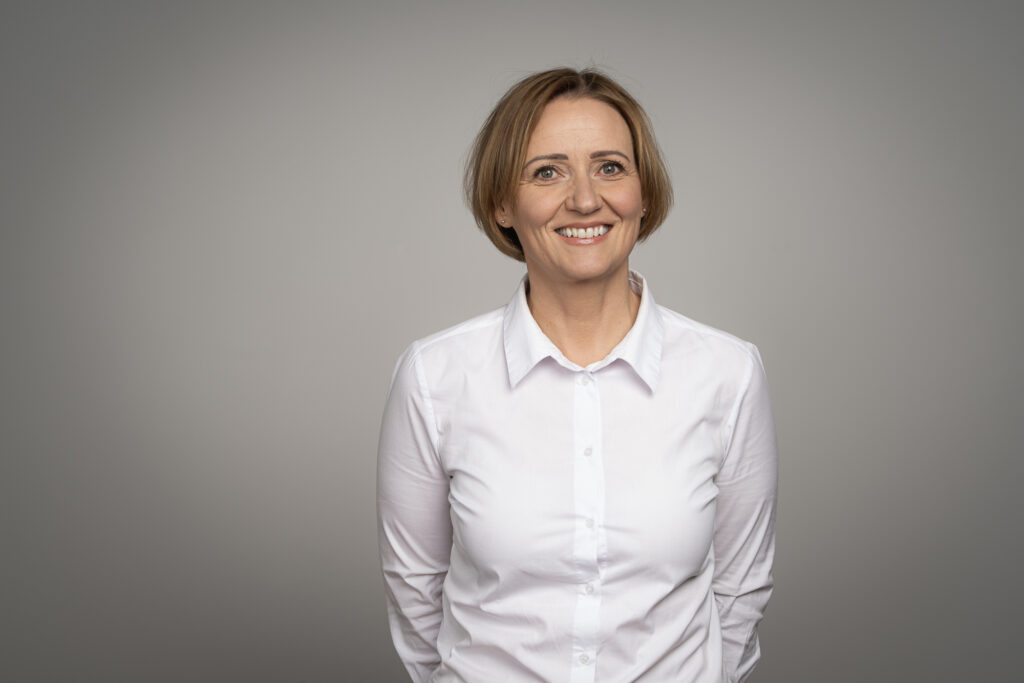
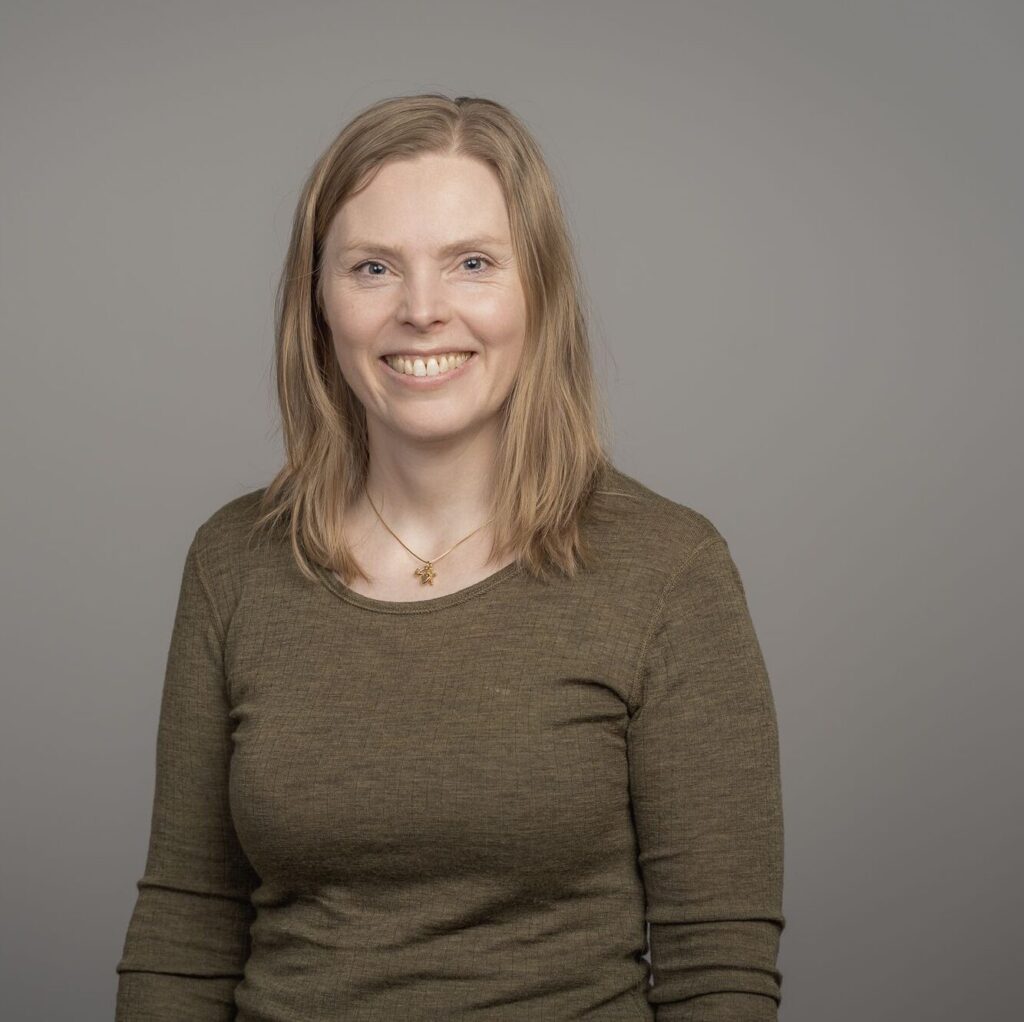
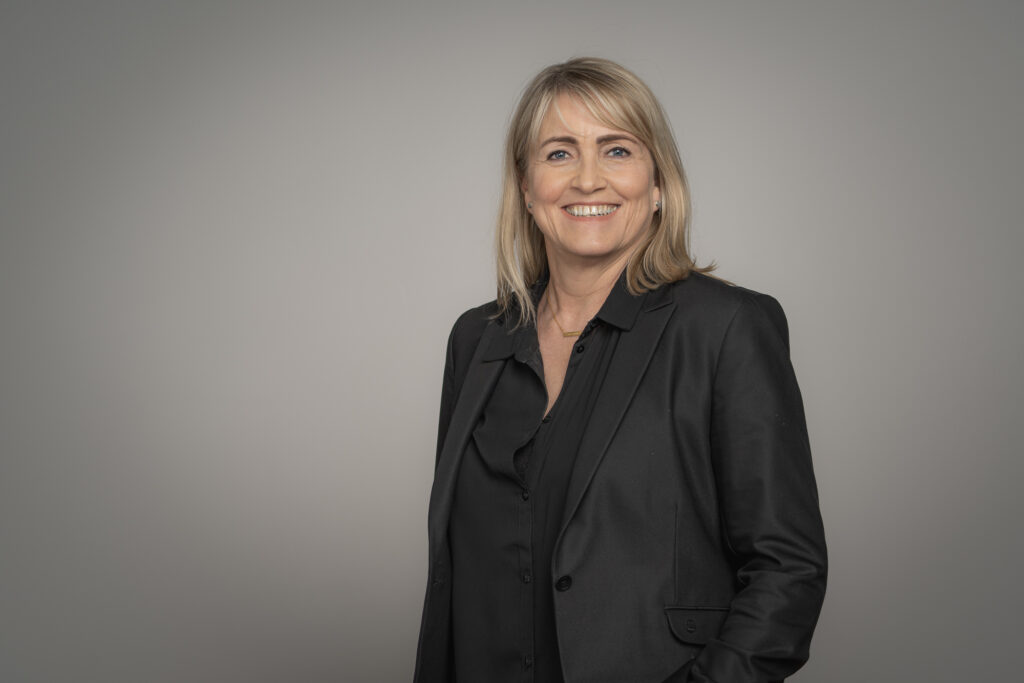
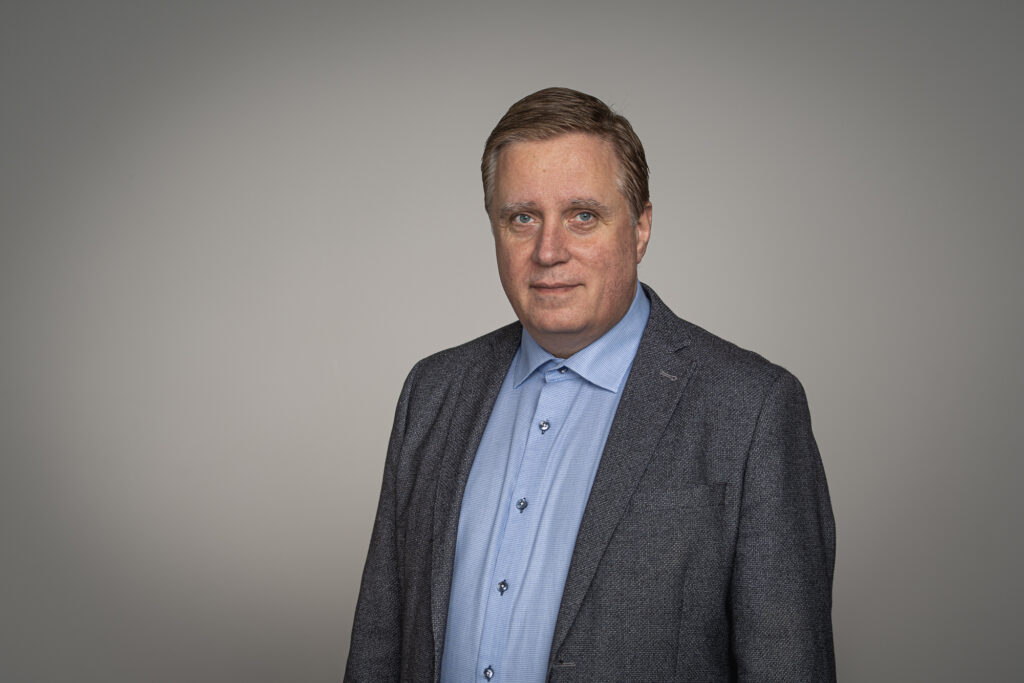
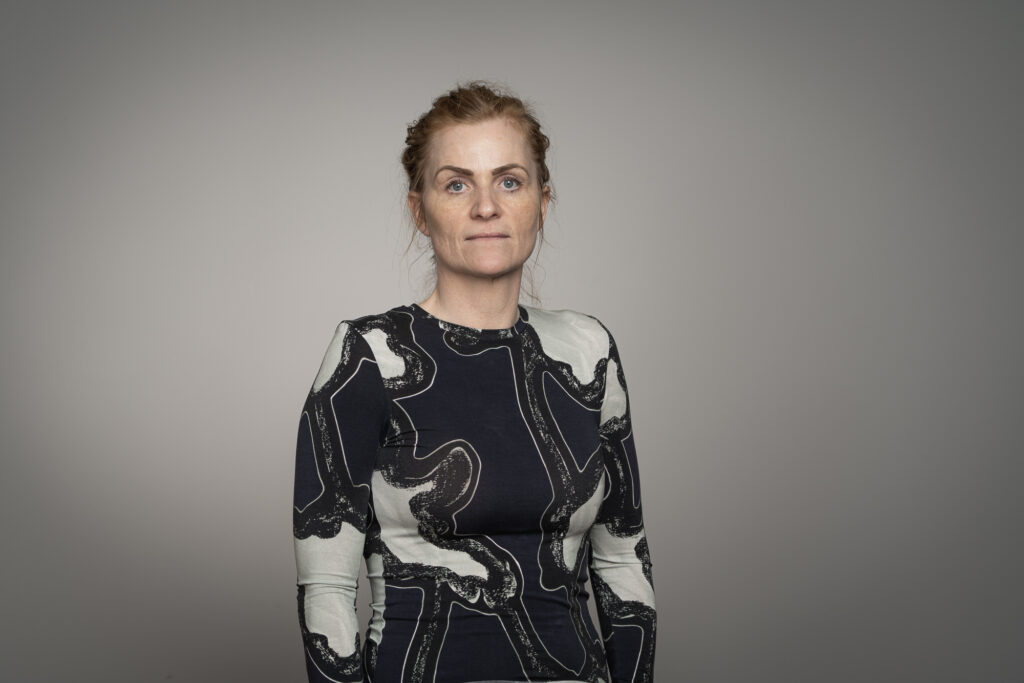
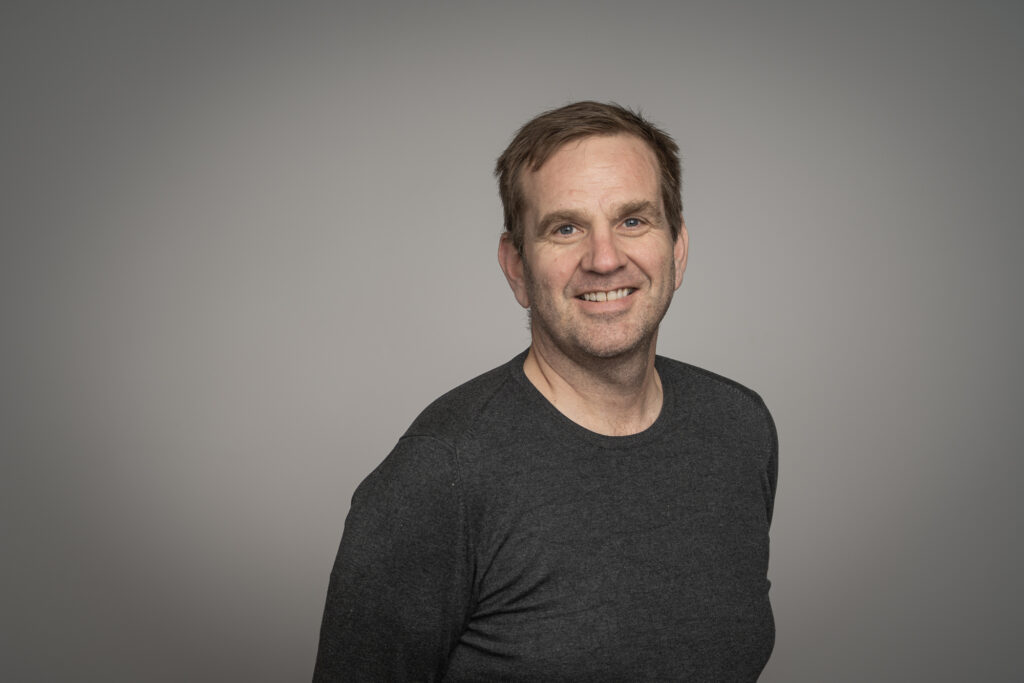

Updated March 28, 2023 (GÓ)